Video is a vital part of every marketing plan but it can be challenging to plan your year’s video content and to create an effective content plan. In this article we’ll give some tips on how to do this. With a bit of planning you can create content that will transform your marketing and set yourself up for years of good content.
At a high level, to create an effective video plan you need to combine (i) your marketing priorities with (ii) a content plan that cuts across the customer sales journey.
Premium vs Derivative Content
First, a quick note. You should think of content as belonging to two types: (i) premium content, (ii) simpler, derivative content. The former is your more complex ‘hero’ content… which uses original artwork and is done to the highest standard. The latter is simpler work or content that’s based on the visual elements defined in your hero content. If you’re new to your video journey then it helps to create some good premium content first. That way you’ll have a strong visual language defined and ready to go which will help you elevate the standard of your simpler content.
Moving on, here’s how you create your video plan.
Step 1: Start with your marketing priorities
What are the key products and channels you plan to push this year? For example you might say: “This year I want to create a solid set of lead gen content for all my main products.”, or “This year I want to push my data aggregator line of products and I need to nail the big product release at the conference in July.”
Step 2: Factor in your sales funnel
The ‘sales funnel‘ is the journey that your client takes before you make a sale. At the top of the funnel you have the awareness (traffic gen) type of activities while on the bottom you have the sales activities. Video can play an important part in each of these areas. Before planning your content you should consider your own sales funnel to identify any weaknesses or opportunities. You may have gone through a similar, more detailed exercise when creating your marketing plan for the year. As a reminder your sales funnel will typically consist of the below activities.
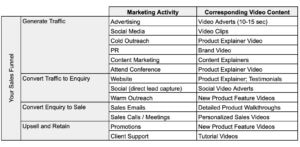
Step 3: Create your Content List
Next, create a list of content to create that covers the different areas of the sales funnel. You can do this with your video agency‘s input as you’ll need to factor in production budgets. Below we’ve given some sample ideas for various budget levels. This list will obviously depend on which video agency you use because pricing varies.
First up, at the lower budget levels, a good approach is to create one or two pieces of hero content and then use derivative content to cover more parts of the sales funnel.
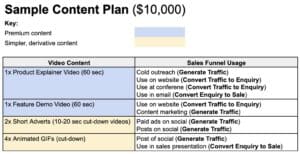
As you can see below, as your budgets increase you may create more premium content for paid advertising (for example) and to cover various parts of the sales funnel including activities like content marketing.
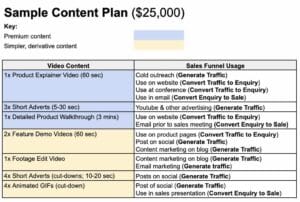
And below is another example at higher budget, showing greater product and sales funnel coverage.
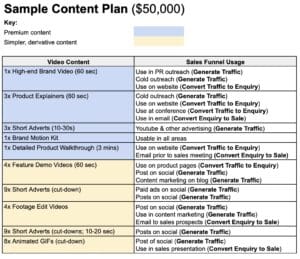
At a bigger budget you can get full-funnel coverage for multiple products and also, for example, include retention based initiatives.
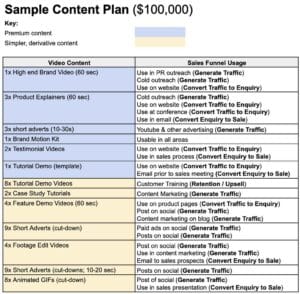
Tip: Make a Brand Motion Kit
If you want to do a lot of work with footage or screen demos then you should also consider creating a ‘brand motion kit’ which is a set of predefined animations that can be easily customized. This includes items like lower thirds, logo animations and layouts for various title and typography frames. This allows an editor with minimal design and animations skills to put together good looking videos based on footage and even simple demo videos.
Factor in Your Team’s Time
If you have a big content pipeline but you have lots of stakeholders who need to approve things then it pays to plan ahead. Try to carve out approval authorities ahead of time. But beware of over-involved CEO types who refuse to be involved in key approvals but still want to make big last minute changes! Another approach is to scale down the size of your review team once you’ve made key hero content.
Final Thoughts
The above are just sample breakdowns so don’t feel constrained. You will have your own priorities so have fun creating your own video journey when you plan your year’s video content. Do you need help putting together your plan? Pop us a message and let’s chat. You can also view our video portfolio or YouTube page for some style ideas.
